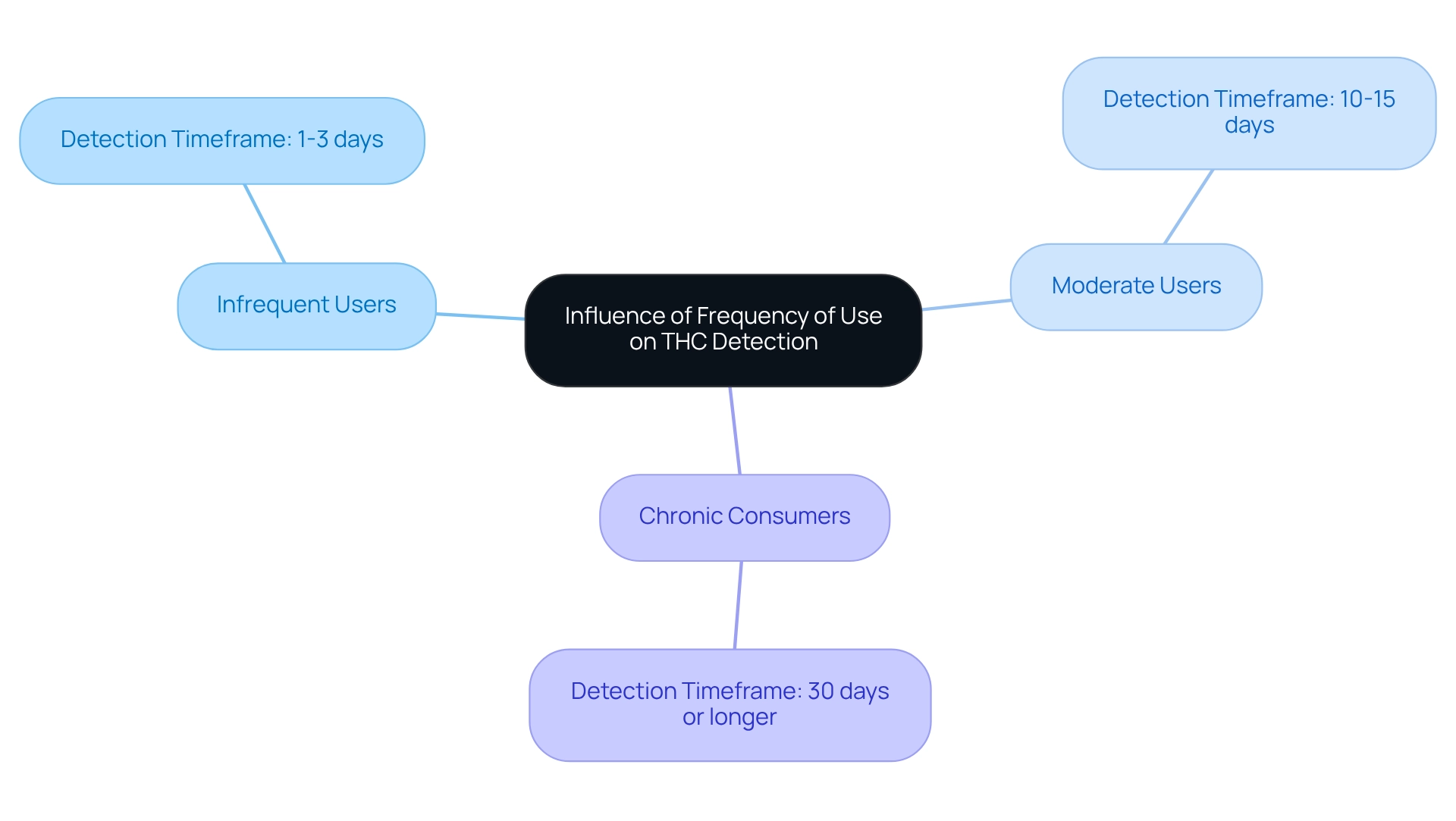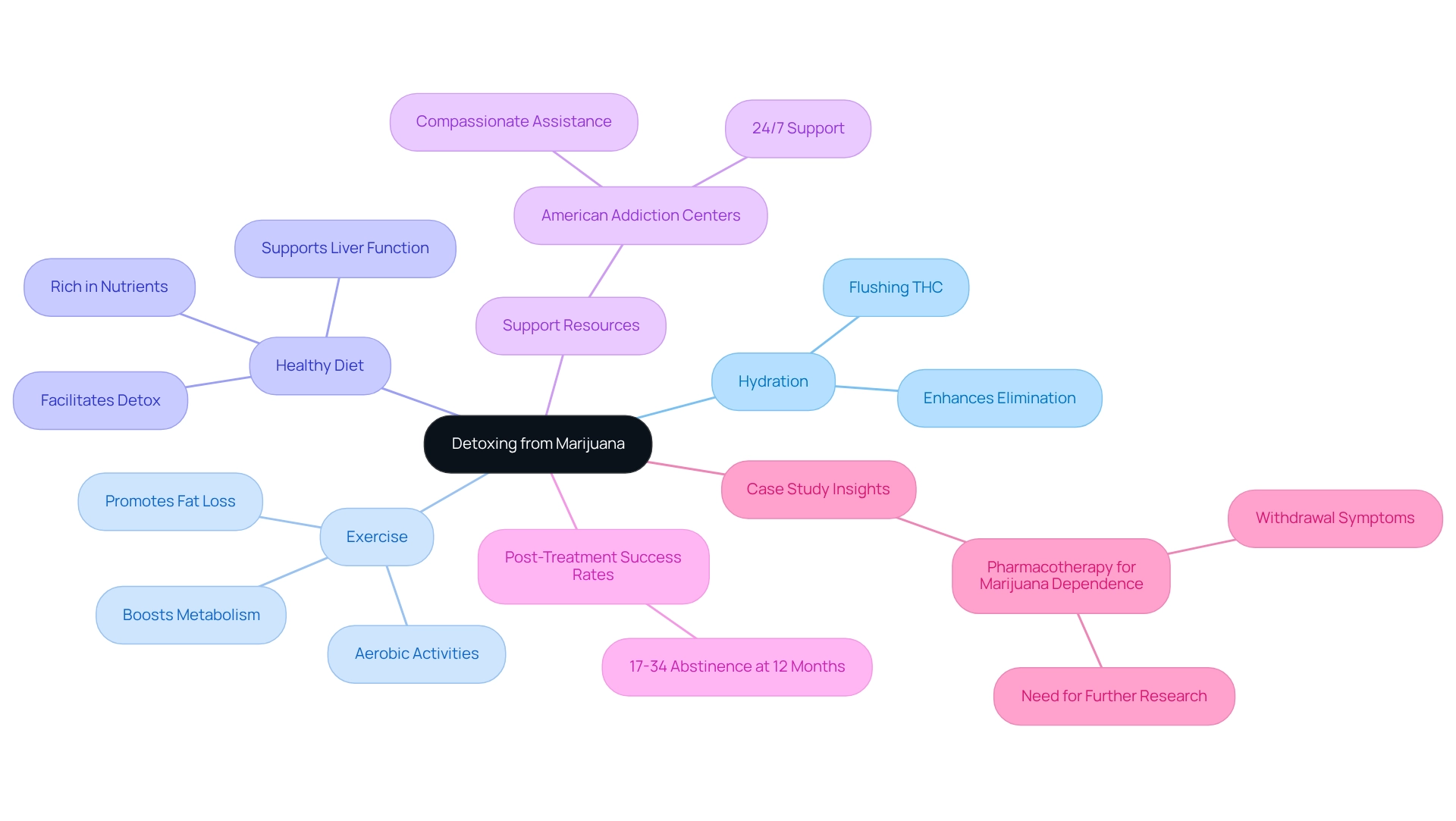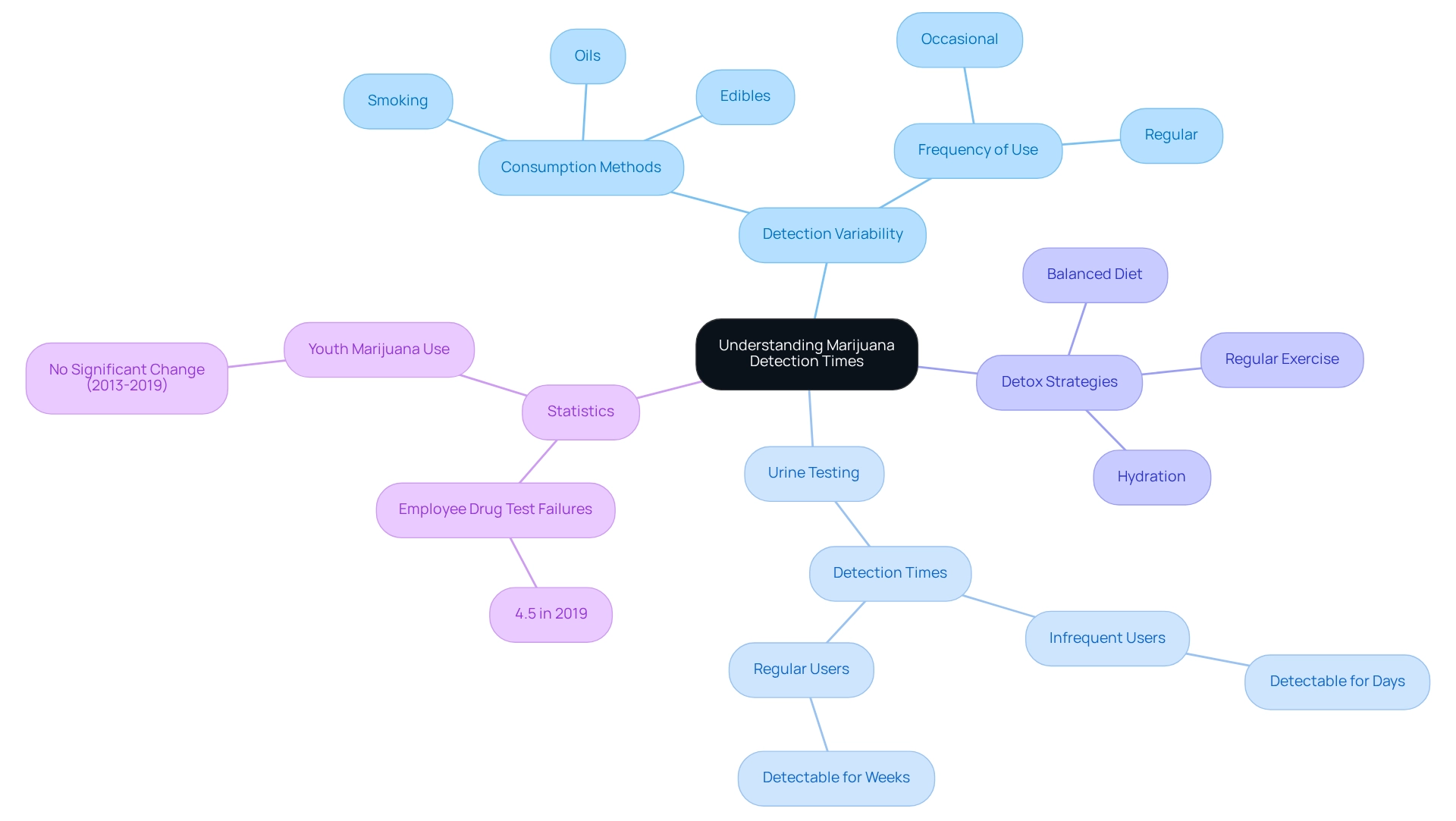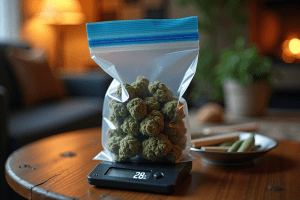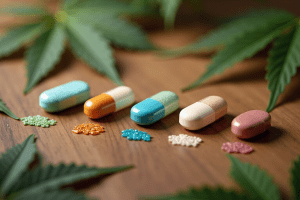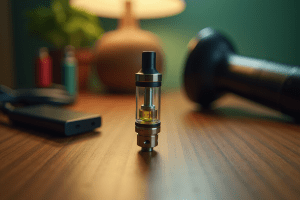Overview
Marijuana can remain in your system for different lengths of time based on several factors, including how often you use it, your body composition, metabolism, and the method of consumption. For regular users, THC can be detectable in urine for up to 30 days, while occasional users may find it detectable for 3 to 10 days. Understanding these variations is crucial, especially for those facing drug testing. Have you ever wondered how these factors might affect you personally?
This article delves into the nuances of THC detection times, highlighting the importance of being informed. By recognizing how your habits and body interact with marijuana, you can make better choices for yourself. We also outline effective detox strategies, such as staying hydrated and incorporating exercise, which can help speed up the elimination process. Together, we can navigate these challenges and empower ourselves with knowledge.
Introduction
In a world where cannabis use is becoming increasingly normalized, it’s important for users to understand how long marijuana can be detected in the body. This knowledge is crucial for navigating employment and legal situations. Detection times can vary significantly depending on factors such as how often you use cannabis, the method of consumption, and the type of drug test being administered. For example, occasional users might clear THC from their systems within just a few days, while regular users could face detection windows that extend beyond a month.
This article will explore the intricacies of marijuana detection times, shedding light on the science behind THC metabolism, the impact of different consumption methods, and effective detox strategies. By understanding these critical aspects, we can make informed decisions about our cannabis use and its implications in a testing environment. Together, let’s navigate this complex landscape with knowledge and support.
Understanding Marijuana Detection Times
Marijuana identification times refer to how long THC (tetrahydrocannabinol), the psychoactive component of cannabis, can be detected in the body after consumption. These times can vary widely based on several factors, such as the method of consumption, frequency of use, and the type of drug test used. For instance, THC can typically be found in urine for up to 30 days in regular users, while occasional users may test positive for a shorter duration, usually between 3 to 10 days.
Understanding these testing durations is particularly important for those who may face drug screenings for employment or legal reasons. A notable case study highlights the necessity for healthcare professionals to inform patients about the limitations of marijuana as a treatment option, especially concerning its potential risks and the need for more thorough research. While marijuana may help enhance appetite and relieve mild nausea, its prescription should be approached with caution until more definitive evidence is available.
Current statistics reveal that average identification times for THC can differ significantly. For example, a 2025 report indicates that frequent users may experience identification times exceeding 30 days, while infrequent users might see results within a week. Experts emphasize the importance of grasping the nuances of THC metabolism, particularly regarding employment and legal implications.
Paul Jannetto, Ph.D., underscores the need to differentiate between new and residual marijuana consumption and to calculate the carboxy-THC to creatinine ratio. This can provide valuable insights into identification times.
Real-world examples illustrate the differences in identification times between regular and occasional users. Frequent users often face longer identification periods due to THC accumulation in body fat, while infrequent users may eliminate THC more quickly. It’s also crucial to note that passive inhalation of marijuana smoke by a non-user is unlikely to yield a positive urine test result; however, caution should still be exercised in determining minimum sensitivity limits.
This variability highlights the importance of understanding how long marijuana stays in your system, especially in situations where drug testing is a concern. Additionally, cannabis withdrawal symptoms, such as irritability and disrupted sleep, can impact an individual’s experience with marijuana and its detection in the body. This emphasizes the need for thorough understanding among consumers, as we navigate these complexities together.
Factors Affecting Marijuana Detection Duration
Several factors significantly influence how long marijuana remains detectable in the body, and understanding these can empower you to make informed choices.
- Frequency of Use: If you’re a regular user, you may find that THC lingers in your system longer than for occasional users. This is due to the cumulative effects of consistent consumption. It’s important to note that studies suggest around 30% of marijuana consumers may develop some degree of use disorder, highlighting the need to comprehend your usage patterns.
- Body Composition: THC is fat-soluble, meaning that individuals with higher body fat percentages might store THC for extended periods. This retention can be particularly pronounced for those who start using marijuana at a young age, as early exposure increases the risk of developing marijuana use disorder. A case study noted the prevalence of this disorder among users, underscoring the importance of being aware of your habits.
- Metabolism: A faster metabolism can facilitate quicker elimination of THC from your body. If you have a higher metabolic rate, you may find that THC is processed and expelled more rapidly, which can influence how long it remains detectable.
- Hydration Levels: Staying well-hydrated can aid in flushing out THC metabolites more efficiently. This can impact how long weed stays in your system. Adequate hydration may help mitigate detection times, as THC can remain detectable in urine tests for a duration ranging from three to thirty days, depending on various factors.
- Consumption Method: The way you consume marijuana—whether by smoking, ingesting edibles, or using oils—also affects how THC is metabolized and stored. For example, edibles may lead to a more prolonged presence of THC in your system compared to smoking, which is typically detectable for shorter periods.
- Testing Methods: Different drug screening techniques have varying identification periods. For instance, urine tests can reveal marijuana for three to thirty days, blood tests for three to four hours, saliva tests for up to 72 hours, and hair tests for up to 90 days. Understanding these methods is essential for anyone wanting to foresee identification times based on their specific situations.
As Janith Galhenage mentions, “This is the longest observation period of urinary cannabinoid metabolites after abstaining from cannabis use.” By considering factors such as body composition and frequency of use, we can better navigate the complexities of marijuana identification and its implications for our health and lifestyle. Together, let’s explore these aspects to make informed and supportive choices.
Overview of Drug Testing Methods for Marijuana
Several common methods are employed to test for marijuana use, each with distinct detection windows and characteristics:
- Urine Testing: This is the most prevalent method, capable of detecting THC metabolites for up to 30 days in chronic users and between 3 to 10 days in occasional users. Its widespread use is attributed to its cost-effectiveness and ease of administration.
- Blood Testing: Typically, blood tests can detect THC for a shorter duration, usually up to 12 hours after use. However, for heavy users, this window may extend beyond 12 hours, reflecting the complexities of THC metabolism in the body.
- Saliva Testing: Saliva tests can identify THC for a period ranging from 1 to 72 hours post-consumption. The identification window varies based on the frequency of use and individual metabolic rates, making it a useful method for recent use.
- Hair Testing: This method can help determine how long weed stays in your system, as it detects THC for up to 90 days by analyzing the presence of THC metabolites in hair follicles. While it offers a longer detection window, it is less commonly used due to higher costs and the time required for results.
Each testing technique showcases its own advantages and drawbacks, highlighting the necessity for individuals to comprehend which method might be applied in their particular situations. Have you ever wondered how these methods could impact your daily life? Recent studies indicate that mandatory drug testing can enhance workplace productivity and safety, reduce absenteeism, lower healthcare costs, and improve overall health and safety. This highlights the relevance of these testing methods in various settings.
Furthermore, resources like the State Cannabis Policy Enactment Database and the Alcohol Policy Information System (APIS) provide up-to-date information on cannabis legislation, supporting informed decision-making among policymakers and the public. As Michael Kosnett, MD, MPH, notes, “With this test’s specificity of 98%, we can have high confidence that this isn’t a false positive.” Additionally, each year, approximately 50,000 students in 8th, 10th, and 12th grades are surveyed about substance use, including cannabis, providing broader context on cannabis use trends among youth.
As the legal landscape surrounding cannabis continues to evolve, staying informed about these testing methods is crucial for both consumers and employers alike. Together, we can navigate this complex issue with understanding and compassion.
Detection Times in Urine, Blood, Saliva, and Hair
Detection times for marijuana can vary significantly depending on the type of test administered. Understanding these differences can help you navigate the complexities of drug screening with confidence and care.
- Urine: For regular users, THC can be detectable for up to 30 days, while occasional users may find it detectable for 3 to 10 days. This prolonged observation period is particularly important for those who might face drug testing in job or legal situations.
- Blood: THC is usually identifiable in blood for up to 12 hours after use. However, frequent users might experience longer detection times due to the buildup of THC in their system.
- Saliva: The identification window for saliva tests spans from 1 to 72 hours after consumption, influenced by factors like frequency of use and personal metabolism.
- Hair: Hair tests can reveal THC presence for up to 90 days, making them a reliable indicator of long-term use.
Comprehending these testing windows is crucial for individuals navigating drug screening situations. For instance, consider the case study on marijuana and breastfeeding, which highlights that THC can enter breast milk. This poses risks to nursing infants, who may test positive for THC and exhibit symptoms such as poor muscle tone. Being aware of how long cannabis stays in your system can be essential in various contexts.
As the cannabis landscape continues to evolve, with sales of edibles in the U.S. and Canada expected to surpass $4.1 billion, it’s vital to stay informed about testing periods and methods. This knowledge supports responsible use and adherence to regulations. Home tests can also assist individuals in checking for cannabis presence, with most users eliminating it within 30 days. Ultimately, as Zawn Villines notes, “there is no definitive method to get cannabis out of the body faster.” This reinforces the importance of awareness and caution in cannabis consumption. Together, we can navigate these challenges with understanding and support.
Impact of Consumption Methods on Detection Times
The method of cannabis consumption plays a crucial role in determining how long THC remains detectable in the body. Each consumption method has distinct characteristics that influence both the onset of effects and the duration of THC detection:
- Smoking: This method typically results in a rapid onset of effects, as THC enters the bloodstream quickly through the lungs. The experience of smoking can vary widely; whether it’s the fiery dance of a joint, the smooth embrace of a glass pipe, or the quick pleasure of a one-hitter, each method offers a unique sensory journey. The ritual of smoking—the flick of the lighter, the inhalation of that first breath, and the release of tension as the smoke swirls around you—creates a moment of pure freedom. However, despite the quick metabolism, it raises the question: how long does weed stay in your system? THC can still be detected in urine for several days after use, depending on frequency and quantity. Real-world examples show that identification times can vary greatly, with smoking generally leading to a recognition period of 1 to 3 days.
- Edibles: Consuming cannabis in edible form leads to a slower metabolism, as THC is processed through the liver. This can lead to extended effects and possibly longer identification periods, prompting the inquiry: how long does weed stay in your system? THC metabolites may remain for up to several weeks, especially for frequent users. Depending on individual metabolism and usage patterns, one may wonder how long does weed stay in your system, as detection times for edibles may extend to 5 to 10 days or longer.
- Vaping: Similar to smoking, vaping allows for quick absorption of THC, but it may produce different metabolite profiles. Ryan Vandrey, PhD, notes that “vendors and consumers of cannabis products should be aware that inhaling cannabis with a vaporizer could produce more pronounced drug effects and impairment than traditional smoking methods.” This variation can influence identification times, with some studies suggesting that vaping might result in more pronounced drug effects compared to traditional smoking methods.
- Concentrates: These products have greater levels of THC, which can considerably prolong identification times due to the increased overall intake. Users of concentrates should be particularly mindful of how long does weed stay in your system, as it may impact drug testing outcomes.
- Tinctures: Tinctures offer a fast-acting alternative to traditional methods, allowing for precise dosing and versatile usage. They can be taken sublingually for quick effects or added to food and drinks, providing a discreet option for consumption. The advantages of tinctures consist of their capacity to deliver THC effectively while reducing the influence on testing times, rendering them an attractive option for numerous consumers.
Comprehending these differences is crucial for individuals to foresee how their consumption choices may affect how long does weed stay in your system in relation to drug testing outcomes. Additionally, the regulatory environment surrounding cannabis consumption, such as New Jersey’s 200-foot buffer zone for cannabis advertising compared to Connecticut’s 1500-foot zone, may influence consumer choices and perceptions. Furthermore, the debate on cannabis as a gateway drug illustrates the complexity of substance use patterns and how they relate to consumption methods.
By being informed about these factors, cannabis consumers can make more educated decisions regarding their consumption methods while also considering the need for policies to prevent youth cannabis use. At Leafy Mate, we encourage you to explore these various methods and find what works best for you.
How Frequency of Use Influences Detection
The frequency of marijuana use significantly influences how long THC remains detectable in the body, with distinct detection timeframes for different user categories:
- Infrequent Users: Individuals who use marijuana occasionally may test positive for THC for only a few days after consumption. Research suggests that occasional users can anticipate THC to exit their system within 1 to 3 days, depending on personal metabolism and the quantity ingested.
- Moderate Users: Those who consume marijuana several times a week may find THC detectable for a longer period, typically ranging from 10 to 15 days. This prolonged identification window is due to the accumulation of THC metabolites in the body, which can vary based on factors such as body fat percentage and overall health.
- Chronic Consumers: Regular individuals, who consume marijuana daily or nearly every day, can have THC detected in their system for 30 days or longer. This extended identification is attributed to the body’s ability to store THC in fat cells, leading to a gradual release back into the bloodstream.
Understanding these testing timeframes is essential for users who might undergo drug examinations, as it directly relates to their chances of testing positive. Importantly, a study highlighted a notable rise in emergency department visits associated with cannabis use among people aged 65 and above. This underscores the importance of understanding THC identification and its effects on health and safety in this group.
Moreover, we encourage healthcare providers to discuss cannabis use with specific populations, such as pregnant women and older adults, to ensure informed decision-making and safe practices. The case study named “Considerations for Specific Patient Populations” highlights the distinct issues concerning cannabis use in these groups, especially in connection to THC identification.
Incorporating insights from Megan Patrick, Ph.D., a research professor at the University of Michigan, it is essential to recognize the value of studies like the Monitoring the Future (MTF) survey. These studies show how drug use trends evolve over decades and across developmental stages. This viewpoint emphasizes the wider consequences of marijuana consumption and identification periods over time.
In summary, the frequency of marijuana consumption plays a crucial role in determining THC identification times. Occasional consumers experience shorter identification periods compared to habitual consumers. This knowledge empowers us to make informed choices regarding our cannabis consumption, particularly in environments where drug testing may occur.
Tips for Detoxing from Marijuana
For individuals seeking to detox from marijuana, understanding how long weed stays in your system is essential. Here are several effective strategies that can significantly expedite the process:
- Hydration: Consuming ample water is crucial, as it aids in flushing THC metabolites from the body. Studies indicate that increased hydration can enhance the elimination of THC, making it a fundamental aspect of any detox regimen.
- Exercise: Regular physical activity not only boosts metabolism but also promotes fat loss, which is essential since THC is stored in fat cells. Engaging in aerobic exercises can accelerate the detoxification process, helping to release stored THC more efficiently.
- Healthy Diet: A balanced diet rich in fruits, vegetables, and fiber supports the body’s natural detoxification processes. Nutrient-dense foods can enhance liver function and overall health, facilitating a more effective detox.
It’s important to consider how long weed stays in your system, as allowing time for the body to metabolize and eliminate THC naturally remains one of the most effective detox methods. While various detox products are available, their effectiveness can be inconsistent. Natural approaches are generally recommended for optimal results.
By incorporating these strategies, you not only aid in detoxification but also promote overall well-being. A case study on pharmacotherapy for marijuana dependence highlights the importance of combining lifestyle changes with medical support to alleviate withdrawal symptoms effectively.
Furthermore, statistics show that maintaining a healthy lifestyle can enhance the likelihood of successful marijuana abstinence. Rates at 12 months post-treatment range from 17 to 34 percent across various treatments. This underscores the value of hydration, exercise, and diet in the detox process. Additionally, individuals struggling with marijuana use can find support through organizations like American Addiction Centers (AAC), which offers compassionate assistance and resources.
By adopting these methods together, we can navigate the detox journey more effectively and responsibly.
Key Takeaways on Marijuana Detection
Understanding how long weed stays in your system is crucial for cannabis consumers, particularly when drug testing may be a factor. Let’s explore some key insights regarding marijuana identification times:
- Variability in Identification: The time THC remains detectable varies based on how you consume it—whether by smoking, edibles, or oils—as well as your usage frequency, whether occasional or regular, and the type of drug test being used, like urine, blood, saliva, or hair.
- Urine Testing Dominance: Urine tests are the most common form of drug testing and can detect THC for different lengths of time. For those who use cannabis infrequently, THC might be detectable for just a few days. In contrast, regular users may find it detectable for weeks. This raises an important question: how long does weed stay in your system? Factors such as body composition, metabolism, and overall health play a role here. For instance, a higher body fat percentage may lead to longer detection times due to THC’s fat-soluble nature.
- Detox Strategies: If you’re looking to detox from marijuana, consider hydration, regular exercise, and a balanced diet. These steps may help speed up the elimination of THC from your body.
The history of drug testing in the workplace began in the military and has since expanded to various sectors. Real-life examples illustrate the importance of knowing these response times. For instance, individuals preparing for employment drug screenings have successfully navigated this process by timing their cannabis use and using effective detox strategies.
Recent statistics underscore the relevance of this knowledge: in 2019, 4.5% of employees failed drug tests, marking the largest increase in nearly two decades. This emphasizes the need for individuals to be aware of how their cannabis consumption might impact their professional lives. Additionally, a report on youth marijuana consumption indicated no significant changes in past 30-day use among young people from 2013 to 2019, while school suspensions related to drugs varied, highlighting how testing times can affect youth discipline.
Experts emphasize that understanding how long weed stays in your system empowers users to make informed choices about their cannabis consumption, especially in contexts where drug testing is a concern. As Justin Kreuter, M.D., pointed out in a discussion on cannabis and drug testing, grasping these factors is vital for responsible consumption. As research continues to evolve, understanding marijuana detection times remains an essential aspect of responsible cannabis use.
Conclusion
Understanding the intricacies of marijuana detection times is essential for both casual and regular users, especially in contexts where drug testing is a possibility. Have you ever wondered how long THC remains detectable in your body? The duration varies significantly based on factors such as frequency of use, method of consumption, and the type of drug test administered. Regular users may find THC detectable for weeks, while occasional users often clear it much faster. This variability highlights the importance of being informed about your consumption habits and the potential implications for employment and legal situations.
Moreover, it’s important to consider individual factors like body composition and metabolism. Individuals with higher body fat percentages may retain THC for longer periods, while those with faster metabolisms may process it more quickly. Understanding these nuances equips us with the knowledge necessary to navigate the complexities of cannabis use responsibly. Together, we can make informed choices that prioritize our well-being.
For those seeking to detox from marijuana, adopting effective strategies—such as staying hydrated, exercising regularly, and maintaining a healthy diet—can significantly aid in expediting the elimination of THC from the body. Have you tried any of these methods? Ultimately, awareness of detection times and the factors that influence them empowers us to make informed decisions about our cannabis consumption. By staying compliant with regulations and being mindful of our health, we can cultivate a responsible approach to cannabis use. As the landscape surrounding cannabis continues to evolve, staying educated on these matters is crucial for all of us.
Frequently Asked Questions
What are marijuana identification times?
Marijuana identification times refer to how long THC (tetrahydrocannabinol), the psychoactive component of cannabis, can be detected in the body after consumption. These times can vary widely based on factors like method of consumption, frequency of use, and type of drug test used.
How long can THC be detected in the body for regular and occasional users?
THC can typically be found in urine for up to 30 days in regular users, while occasional users may test positive for a shorter duration, usually between 3 to 10 days.
Why is it important to understand marijuana identification times?
Understanding these testing durations is particularly important for individuals who may face drug screenings for employment or legal reasons.
What factors influence how long marijuana remains detectable in the body?
Several factors influence detection times, including frequency of use, body composition, metabolism, hydration levels, consumption method, and testing methods.
How does frequency of use affect THC detection times?
Regular users may find that THC lingers in their system longer due to cumulative effects, while infrequent users may eliminate THC more quickly.
How does body composition impact THC retention?
THC is fat-soluble, meaning individuals with higher body fat percentages might store THC for extended periods, especially if they started using marijuana at a young age.
Does metabolism play a role in THC elimination?
Yes, individuals with a faster metabolism may process and expel THC more rapidly, influencing how long it remains detectable.
Can hydration levels affect how long THC stays in the system?
Staying well-hydrated can aid in flushing out THC metabolites more efficiently, potentially reducing detection times.
How does the method of consumption impact THC detection?
Different consumption methods affect how THC is metabolized and stored. For example, edibles may lead to a more prolonged presence of THC compared to smoking.
What are the different testing methods and their detection times?
Urine tests can detect marijuana for three to thirty days, blood tests for three to four hours, saliva tests for up to 72 hours, and hair tests for up to 90 days.
What should consumers be aware of regarding cannabis withdrawal symptoms?
Cannabis withdrawal symptoms, such as irritability and disrupted sleep, can impact an individual’s experience with marijuana and its detection in the body.
Get Your Medical Card
Connect with a licensed physician online in minutes



